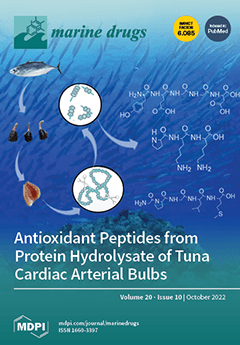Three new ceramides (
1–
3) and three new cerebrosides (
4,
8, and
9), along with three previously known cerebrosides (ophidiocerebrosides C (
5), D (
6), and CE-3-2 (
7)), were isolated from a deep-sea starfish species, the orange cookie starfish
Ceramaster patagonicus. The structures of
1−
4, 8, and
9 were determined by the NMR and ESIMS techniques and also through chemical transformations. Ceramides
1–
3 contain
iso-C
21 or C
23 Δ
9-phytosphingosine as a long-chain base and have C
16 or C
17 (2
R)-2-hydroxy-fatty acids of the normal type. Cerebroside
4 contains C
22 Δ
9-sphingosine
anteiso-type as a long-chain base and (2
R)-2-hydroxyheptadecanoic acid of the normal type, while compounds
8 and
9 contain saturated C-17 phytosphingosine
anteiso-type as a long-chain base and differ from each other in the length of the polymethylene chain of (2
R)-2-hydroxy-fatty acids of the normal type: C
23 in
8 and C
24 in
9. All the new cerebrosides (
4,
8, and
9) have β-D-glucopyranose as a monosaccharide residue. The composition of neutral sphingolipids from
C. patagonicus was described for the first time. The investigated compounds
1–
3,
5–
7, and
9 exhibit slight to moderate cytotoxic activity against human cancer cells (HT-29, SK-MEL-28, and MDA-MB-231) and normal embryonic kidney cells HEK293. Compounds
2,
5, and
6 at a concentration of 20 µM inhibit colony formation of MDA-MB-231 cells by 68%, 54%, and 68%, respectively. The colony-inhibiting activity of compounds
2,
5, and
6 is comparable to the effect of doxorubicin, which reduces the number of colonies by 70% at the same concentration.
Full article






